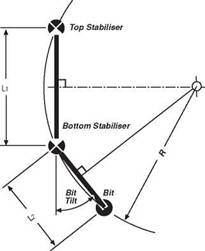 Operation of a Steerable System
Operation of a Steerable System
As described above, the steerable system can drill directionally or straight ahead, as required. This enables the driller to control the well’s trajectory without making timeconsuming trips to change bottomhole assemblies. To steer the hole during kickoffs or course corrections the system is oriented using MWD readings so the bit will drill in the direction of the navigation sub’s offset angle. When drilling in this way the system is said to be drilling in the oriented or sliding (since the drillstring is not rotating) mode. The bit is driven by the downhole motor, and the rotary table is locked in place, as it is when conventional motor drilling. As mentioned previously, the system’s two stabilizers and bit serve as the tangency points that define the curve to be drilled by the oriented assembly. The dogleg rate produced can be controlled by varying the placement and size of the stabilizers, by using a DTU with a different offset angle, or by alternating drilling with oriented and rotary intervals.
|
|
The system can also be used to drill straight ahead by simple string rotation. The rotary table is typically turned at 50-80 RPM while the motor continues to run. When drilling in this way the system is said to be drilling in the rotating mode. Through careful well planning and bottomhole assembly design, oriented sections are minimized and the assembly is rotated as much as possible. This maximizes penetration rates while keeping the well on course. Survey readings from an MWD tool enable efficient monitoring of directional data so the driller can maintain the wellpath close to the desired path. Slight deviations can be detected and corrected with minor oriented drilling intervals before they become major problems.
